Related Research Articles

Pope Benedict XI, born Nicola Boccasini, was head of the Catholic Church and ruler of the Papal States from 22 October 1303 to his death, in 7 July 1304.
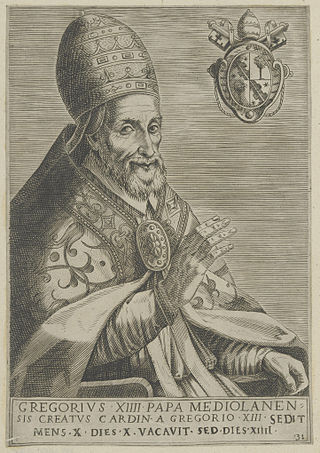
Pope Gregory XIV, born Niccolò Sfondrato or Sfondrati, was head of the Catholic Church and ruler of the Papal States from 5 December 1590 to his death, in October 1591.

Pope Innocent X, born Giovanni Battista Pamphilj, was head of the Catholic Church and ruler of the Papal States from 15 September 1644 to his death, in January 1655.
A jubilee is a special year of remission of sins, debts and universal pardon. In Leviticus, a jubilee year is mentioned to occur every 50th year; during which slaves and prisoners would be freed, debts would be forgiven and the mercies of God would be particularly manifest.

The Catholic Church, also known as the Roman Catholic Church, is the largest Christian church, with 1.28 to 1.39 billion baptized Catholics worldwide as of 2024. It is among the world's oldest and largest international institutions and has played a prominent role in the history and development of Western civilization. The church consists of 24 sui iuris churches, including the Latin Church and 23 Eastern Catholic Churches, which comprise almost 3,500 dioceses and eparchies around the world. The pope, who is the bishop of Rome, is the chief pastor of the church. The Diocese of Rome, known as the Holy See, is the central governing authority of the church. The administrative body of the Holy See, the Roman Curia, has its principal offices in Vatican City, a small independent city-state and enclave within the city of Rome, of which the pope is head of state.
The process of beatification and canonization has undergone various reforms in the history of the Roman Catholic Church. For current practice, as well as a discussion of similar processes in other churches, see the article on canonization. This article describes the process as it was before the promulgation of the Codex Iuris Canonici of 1983.

BartolomeoBorghesi was an Italian antiquarian who was a key figure in establishing the science of numismatics.
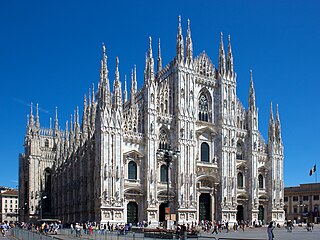
The Archdiocese of Milan is a Latin Church ecclesiastical territory or archdiocese of the Catholic Church in Italy which covers the areas of Milan, Monza, Lecco and Varese. It has long maintained its own Latin liturgical rite usage, the Ambrosian rite, which is still used in the greater part of the diocesan territory. Among its past archbishops, the better known are Ambrose, Charles Borromeo, Pope Pius XI and Pope Paul VI.
A martyrology is a catalogue or list of martyrs and other saints and beati arranged in the calendar order of their anniversaries or feasts. Local martyrologies record exclusively the custom of a particular Church. Local lists were enriched by names borrowed from neighbouring churches. Consolidation occurred, by the combination of several local martyrologies, with or without borrowings from literary sources.

The Italian Catholic Church, or Catholic Church in Italy, is part of the worldwide Catholic Church in communion with the Pope in Rome, under the Conference of Italian Bishops. The pope serves also as Primate of Italy and Bishop of Rome. In addition to the Italian Republic, two other sovereign states are included in Italian dioceses: San Marino and Vatican City. There are 225 dioceses in the Catholic Church in Italy, see further in this article and in the article List of Catholic dioceses in Italy.
The Aquileian Rite was a particular liturgical tradition of the Patriarchate of Aquileia and hence called the ritus patriarchinus. It was effectively replaced by the Roman Rite by the beginning of the seventeenth century, although elements of it survived in St. Mark's Basilica in Venice until 1807.

Annibale Bugnini was an Italian Catholic prelate who served as secretary of the commission that worked on the reform of the Roman Rite following the Second Vatican Council. Both critics and proponents of the changes made to the Mass, the Liturgy of the Hours and other liturgical practices consider him a dominant force in these efforts. He was a member of the Vincentians.

A canonical coronation is a pious institutional act of the pope, duly expressed in a formal decree of a papal bull, in which the pope bestows the pontifical right to impose an ornamental crown, a diadem or an aureole to an image of Christ, Mary or Joseph that is widely venerated in a particular diocese or locality. The act was later regulated to Marian images only, through the De coronatione imaginum B.V. Mariae that was issued on 25 March 1973.
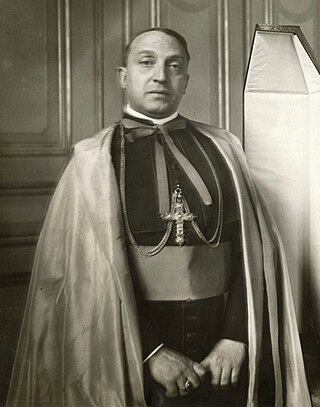
Clemente Micara was an Italian prelate of the Roman Catholic Church. He worked in the diplomatic service of the Holy See from 1909 to 1950 and was Vicar General of Rome from 1951 until his death.
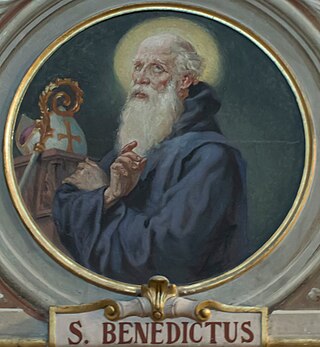
Benedict was Archbishop of Milan from c. 685–732. He is honoured as a saint in the Catholic and Eastern Orthodox Churches.
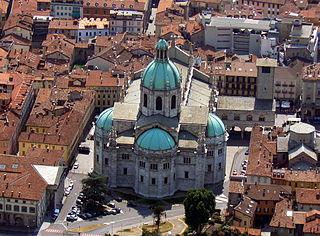
The Diocese of Como is a Latin Church ecclesiastical jurisdiction or diocese of the Catholic Church in northern Italy. It was established in the Fourth Century. It is a suffragan diocese in the ecclesiastical province of the metropolitan Archdiocese of Milan. The Bishop of Como's cathedra is in the Como Cathedral.
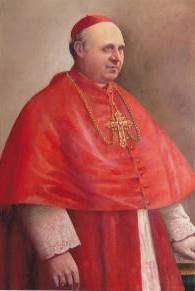
Serafino Cretoni was an Italian Cardinal of the Roman Catholic Church who served as Prefect of the Sacred Congregation of Rites from 1903 until his death, and was elevated to the cardinalate in 1896.

Elio Sgreccia was an Italian bioethicist and a cardinal of the Catholic Church. He was president of the Pontifical Academy for Life, director of the international medical ethics journal Medicina e Morale, president of the Ut Vitam Habeant Foundation and the Donum Vitae Association of the Diocese of Rome, and honorary president of the International Federation of Bioethics Centers and Institutes of Personalist Inspiration (FIBIP).

Giulio Cesare Sacchetti was an Italian Catholic cardinal and was twice included in the French Court's list of acceptable candidates for the Papacy, in 1644 and 1655.
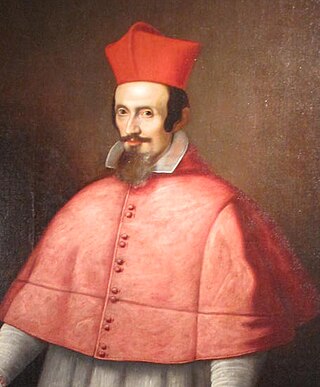
Cesare Monti was an Italian Cardinal who served as Latin Patriarch of Antioch and Archbishop of Milan.
References
 This article incorporates text from a publication now in the public domain : Herbermann, Charles, ed. (1913). "Bartolommeo Gavantus". Catholic Encyclopedia . New York: Robert Appleton Company.
This article incorporates text from a publication now in the public domain : Herbermann, Charles, ed. (1913). "Bartolommeo Gavantus". Catholic Encyclopedia . New York: Robert Appleton Company.